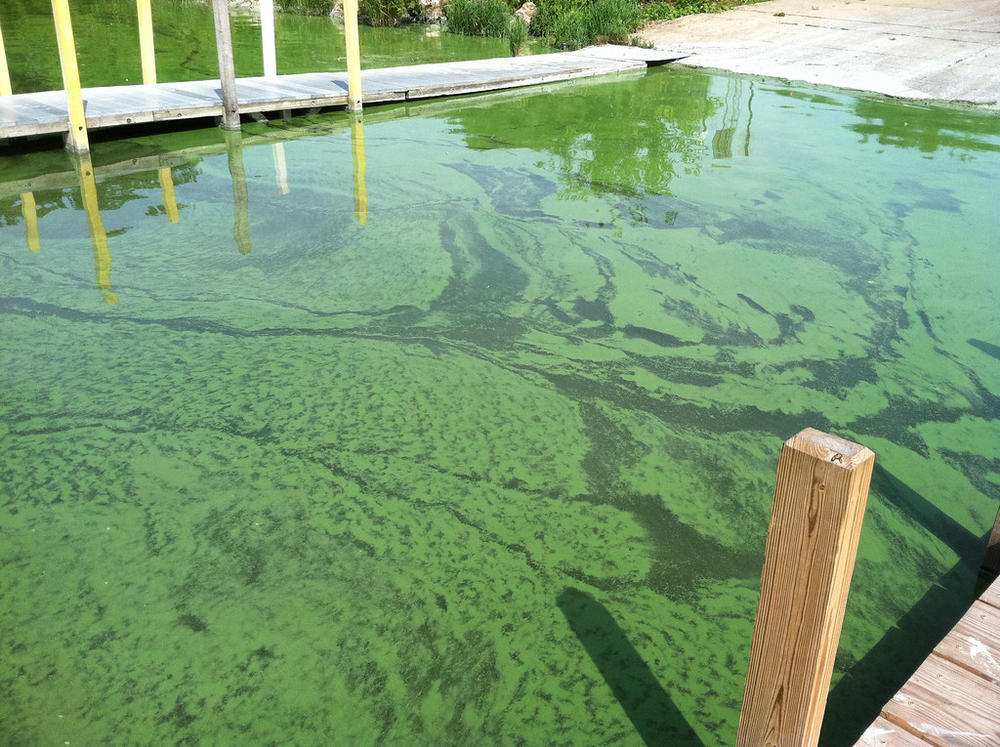
Harmful Algal Blooms
“When in doubt, stay out.”
GA EPD is sharing information on Harmful Algal Blooms to protect you and your pets. If you see a bloom, please use caution. Reporting instructions can be found below.
A Harmful Algal Bloom (HAB) is caused by blue-green algae (cyanobacteria) collecting in open water that become harmful. People and animals that touch, swallow or breath-in toxins from this water can become sick, sometimes suddenly. Not all blooms are harmful.

Identifying A Possible Harmful Algal Bloom
- Water that is bright green, blue, brown, or red in color
- Water cloudiness below the surface
- Water may resemble pea soup or spilled green/blue-green paint and have thick mat-like collections of floating scum
- Stressed or dead fish
What Should You Do If You See a Possible Harmful Algal Bloom?
- Keep children and pets away from the bloom. Do not swim or wade through algal scum. Avoid playing fetch with pets in the water near the bloom.
- If you or your animals touch an algal bloom, do not swallow or inhale the water. Wash with clean water and soap afterward. Wash animals' fur thoroughly before allowing them to lick themselves.
- Do not drink, cook, or shower with untreated water from lakes, ponds, or streams.
- Avoid withdrawing untreated water for irrigation.
- Do not drive your boat, water ski, or jet ski through a bloom.
- Thoroughly rinse your boat used in an area with a bloom.
- Do not fish from lakes, ponds, or rivers with floating algal scum.
- If you or an animal has rash, vomiting, diarrhea, respiratory or nervous system problems, call or visit a healthcare provider soon and be sure to mention the possibility of contacting an HAB..
How To Report a HAB Sighting
If you see what appears to be a large HAB:
- Please contact the Lake Manager immediately (which could be the US Army Corps of Engineers, Georgia Power, Tennessee Valley Authority, Georgia State Parks, etc.)
- Send an email to [email protected] with the following information:
- Name:
- Contact Information (phone and/or email):
- Date and Time of observed bloom:
- Lake/waterbody name:
- Location in lake (i.e. cove, nearest boat ramp or marina, beach, etc.):
- If possible, Latitude and Longitude (GPS coordinates):
- Have you contacted the Lake Manager?: Yes/No
- Short description of bloom:
- Attach photographs:
Frequently Asked Questions:
Q: What causes HABs?
A: HABs occur when algae grow out of control. Excess nutrients, temperature, water circulation, and wind may contribute to HABs, but how these factors come together to create an algae bloom is not well understood.
Q: How do you prevent HABs?
A: Homeowners can reduce fertilizer use and properly maintain their septic systems. Additionally, maintaining the 25-foot vegetated buffer plays an important role in absorbing nutrients before they enter the water. Washing boats before entering new waterbodies can prevent the spread of HABs.
Q: When does EPD sample and test for HABs?
A: The sampling protocol is triggered by visual observation of a suspected bloom. EPD performs visual monitoring on the main channel. If spatial and/or temporal extent of bloom is significant, then samples are collected and sent to Georgia College and State University for identification, enumeration, and toxin analysis. If cyanotoxins are present at toxic levels (8 ug/L Microcystin or 15 ug/L for Cylindrospermopsin), then GA DNR or lake managers will issue swimming advisories. Swim advisory will remain in effect until the bloom dissipates.
Q: Is drinking water in surrounding areas affected?
A: When EPD is notified of a HAB in a waterbody that sources drinking water, we contact the nearby drinking water utilities and share information. Conventional water treatment consists of several steps, including coagulation, filtration, chlorination, and these processes generally remove cyanobacterial cells and low levels of cyanotoxins. Severe blooms require proactive planning and active management to reduce the risks of cyanotoxins in finished drinking water
Q: How do HABs go away?
A: HABs are typically observed during warmer, drier months, and can persist for several weeks. Cooler temperatures, heavy winds, and rain can contribute to HABs breaking up and dying off. Most HABs eventually disappear on their own, naturally.
Q: How do I report possible HABs?
A: If you see what appears to be a large HAB, please contact the lake manager immediately (which could be the US Army Corps of Engineers, Georgia Power, Tennessee Valley Authority, Georgia State Parks, etc.). Also, send an email to [email protected] with the date and time of observed bloom, waterbody name, location, GPS coordinates if possible, and photographs attached.
Q: To whom do we report any illness that humans or dogs get from a HAB?
A: Report HAB-related illnesses in humans to Department of Public Health Epidemiology 24/7 Public Health Report Line | 866-PUB-HLTH (866-782-4584)
For more information about Harmful Algal Blooms, please see GA EPD’s StoryMap